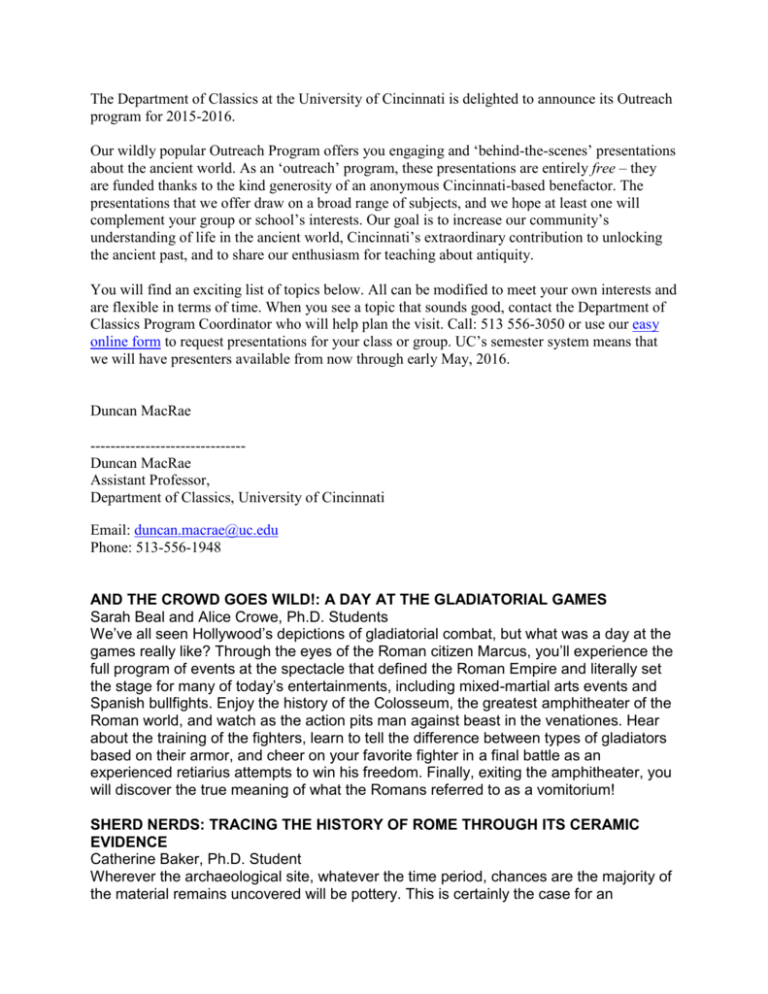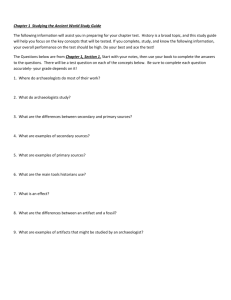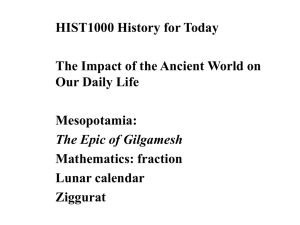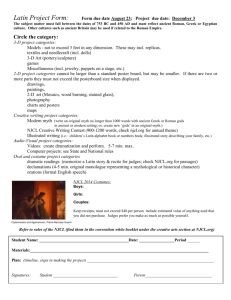Click here to find out more about UC`s program
advertisement

The Department of Classics at the University of Cincinnati is delighted to announce its Outreach program for 2015-2016. Our wildly popular Outreach Program offers you engaging and ‘behind-the-scenes’ presentations about the ancient world. As an ‘outreach’ program, these presentations are entirely free – they are funded thanks to the kind generosity of an anonymous Cincinnati-based benefactor. The presentations that we offer draw on a broad range of subjects, and we hope at least one will complement your group or school’s interests. Our goal is to increase our community’s understanding of life in the ancient world, Cincinnati’s extraordinary contribution to unlocking the ancient past, and to share our enthusiasm for teaching about antiquity. You will find an exciting list of topics below. All can be modified to meet your own interests and are flexible in terms of time. When you see a topic that sounds good, contact the Department of Classics Program Coordinator who will help plan the visit. Call: 513 556-3050 or use our easy online form to request presentations for your class or group. UC’s semester system means that we will have presenters available from now through early May, 2016. Duncan MacRae ------------------------------Duncan MacRae Assistant Professor, Department of Classics, University of Cincinnati Email: duncan.macrae@uc.edu Phone: 513-556-1948 AND THE CROWD GOES WILD!: A DAY AT THE GLADIATORIAL GAMES Sarah Beal and Alice Crowe, Ph.D. Students We’ve all seen Hollywood’s depictions of gladiatorial combat, but what was a day at the games really like? Through the eyes of the Roman citizen Marcus, you’ll experience the full program of events at the spectacle that defined the Roman Empire and literally set the stage for many of today’s entertainments, including mixed-martial arts events and Spanish bullfights. Enjoy the history of the Colosseum, the greatest amphitheater of the Roman world, and watch as the action pits man against beast in the venationes. Hear about the training of the fighters, learn to tell the difference between types of gladiators based on their armor, and cheer on your favorite fighter in a final battle as an experienced retiarius attempts to win his freedom. Finally, exiting the amphitheater, you will discover the true meaning of what the Romans referred to as a vomitorium! SHERD NERDS: TRACING THE HISTORY OF ROME THROUGH ITS CERAMIC EVIDENCE Catherine Baker, Ph.D. Student Wherever the archaeological site, whatever the time period, chances are the majority of the material remains uncovered will be pottery. This is certainly the case for an excavation focused on the Roman world, where the pieces range from transport vessels to elegant dishes. But how do archaeologists study these broken pieces? How can they tell a larger historical story? Join me – a “sherd nerd” who has participated in excavations in both Israel and Italy – as I explain how pottery was produced, moved and used around the Mediterranean. We will also dig in to the ongoing excavations at the Porta Stabia project at Pompeii to see how pottery is removed, sorted and studied. “A FUNNY THING HAPPENED ON THE WAY TO FOUNTAIN SQUARE:” ROME AND THE ROOTS OF THE MODERN CITY Maura Brennan and Haley Bertram, Ph.D. Students If an ancient Roman traveled to modern-day Cincinnati, what would he or she think? Certainly the technology would be shocking, but in many ways, both cities have much in common. Indeed, modern cities trace their roots back to the ancient Greek "polis" and the Roman "civitas," including governmental structures and entertainment facilities. With Rome and Cincinnati, however, the similarities are all the more striking. Let's take a walk along the Ohio and Tiber rivers, comparing the many buildings in terms of their architecture, arrangement and the different functions they play (for example: the Colosseum and Paul Brown Stadium!). We will discover how alike the modern city and its citizens are to the ancient civitas. DIGGING UP HOMER Sarah Beal and Alice Crowe, Ph.D. Students Did the Trojan War really happen? This presentation is designed to give the audience an introduction to the archaeological evidence for one of the most gripping stories of the ancient world, Homer’s Iliad. Discussion focuses on archaeological excavations at Bronze Age palaces in Greece including those of Agamemnon and Nestor at Mycenae and Pylos, and from the citadel at Troy. Different forms of archaeological evidence including ceramics, fortifications, weapons, wall paintings, bones, and bathtubs paint a varied and dynamic picture of an ancient way of life. But is this enough to prove Homer’s tale? To answer this tantalizing question, this presentation looks at the problems involved when Homer and archaeology are brought together and what archaeologists are doing to figure out the best ways to determine if “X” truly marks the spot. ANCIENT VILLAGERS AND CITY SLICKERS Flint Dibble, Ph.D. Student What was it like to live in the past? This presentation brings to life the space and everyday activities of ancient farmers and urbanites. How did an ancient farm work and what kind of jobs did farmers do every day? How can we get at the sights and sounds of living in an ancient city like Athens or Rome, and what did urbanites do to make a living? We will see how archaeologists use the trash of the past to answer these questions. This presentation will step into ancient farmhouses and giant apartment buildings. The secrets of good shepherding and the sales tricks of urban shopkeepers will be revealed. But it won't be all hard work, because the ancients knew how to have fun too! MONEY, MONEY, MONEY! David Schwei, Ph.D. Student We use money every day to purchase things we need or want, but how often do we stop to think about the coins or bills that pass through our hands? What do the designs on the bills and coins mean? Who or what do they honor? Currency provides a unique insight into a culture, and coins are an incredibly common artifact from ancient Greece and Rome. In this presentation we will discuss some of the ways in which Romans used coins as part of their propaganda machines (and which still continues today!), and ways in which we can learn about the ancient economy from the discovery of extraordinary coin hoards. YOU ARE WHAT YOU EAT Flint Dibble, Ph.D. Student What we eat, whom we eat with, and where we eat is extremely important for any meal. This presentation looks at the topic of food in the past and compares it to food in America today: from farm to table. First we will see what food people actually ate back then (bread, olives, and sometimes even mice!). Second, we will look at ancient farming, grocery shopping, and cooking methods. Last, we will see how people ate: from dining at home to eating out in a restaurant to feasting at a public party. While the idea of animal sacrifice might seem odd to us, the event was actually quite similar to a Christmas or Passover dinner or our Fourth of July barbecues. While ancient food would have often tasted much different than today’s, the ancients cared as much about what they ate and whom they sat next to at a meal as we do today. THE ROMAN CONSTITUTION OF THE UNITED STATES OF AMERICA David Schwei, Ph.D Student Democracy. Americans have sought to spread this form of government throughout the world in the twentieth century, but how did we get it? The United States of America was born from one of many monarchies of the eighteenth century. In a rejection of monarchy, the Founding Fathers sought inspiration in the ideas of Montesquieu and especially in the ideas of the ancient Greeks and Romans. The Fathers were steeped in classical education. They studied ancient Greek and Latin at school, assembled libraries of classical literature, and imitated ancient architecture, such as at Thomas Jefferson’s Monticello. This presentation will discuss the influence of ancient Greek and Roman authors on the American constitution: how the writings of the statesman Cicero and of the historian Polybius guided James Madison. THE ROMAN ARMY: THE PEOPLE WHO BROUGHT YOU THE ROMAN EMPIRE C.J. Miller, Ph.D. Student Today, mention of the Roman army might conjure up images of movies like Gladiator or of reenactors posing for photographs outside the Colosseum. In antiquity, however, the Roman army was a powerful force, not just militarily. It developed the road network that tied the empire together, brought men from around the Mediterranean to defend the borders, and took Rome from a village on the banks of a modest Italian river to unrivaled mastery of the western world. Along the way, it brought Cincinnatus, Julius Caesar, and Constantine (among others!) their fame and power. This talk will explore the life and times of the Roman army—how they fought, what they carried, and what they did when they weren’t fighting—using the wealth of available evidence, from literature and fine sculpture to the letters they wrote, the shoes they wore, and the graves they left behind. POMPEII: LIFE FROM THE ASHES Catherine Baker, Ph.D Student Walk with ancient Romans! This presentation will take students on a virtual tour of Pompeii, a Roman city buried in the eruption of Mount Vesuvius in 79 A.D. Tour stops will include the town forum, an elite house, a “fast food joint,” the theatre district, the amphitheatre, and the cemeteries outside the city walls. At each stop, we will examine the ways in which the Latin language and the material remains of the town come together to bring the Roman past to life. The presentation will conclude with an interactive project. Students or residents, working in groups and with the aid of a glossary, will translate several inscriptions from Pompeian tombs. The entire group will then reconvene to discuss what the tombs tell us about the individuals buried there, and to imagine the places within the city where those individuals might have lived, worked, and played. STEP RIGHT UP: A TOUR OF THE ACROPOLIS OF ATHENS Sabina Ion, Ph.D. Student A stone outcrop rising over the heart of Athens, the Acropolis was an important center of ancient Athenian religious worship and community gathering, and remains one of the most iconic images of the ancient world. In the 5th century BC, the Acropolis was the site of a large-scale building program, instigated by the general Pericles. During this time, the Acropolis and its new monuments, especially the Parthenon, became the symbol of Athens and Athenian greatness in the ancient Greek world. This richly illustrated presentation offers an overview of the history and monuments of the Acropolis, emphasizing the important roles the Acropolis played in how the people of Athens related to their gods, themselves, and others. IRON MEN AND MUTANTS: WHAT ARE HEROES MADE OF? Charles Sturge, Ph.D. Student Superman. Percy Jackson. Voldemort. Batman. The Joker. Medusa. In modern film, literature, and art, we regularly encounter fictional characters who represent ideals of heroism and villainy. Stories about heroes and villains are not just entertaining, they also reveal information about the dos and don’ts of our contemporary society. Ancient Greeks and Romans also loved to tell tales about heroes who were sent on quests to prove their abilities and to help keep the land safe from monsters and brigands. These myths were used in antiquity to express complex ideas about ancient ethics, civic pride, and cultural identity. This interactive presentation analyzes our concept of heroism and compares it with that of the ancient Greeks and Romans through the stories of Hercules, Perseus and other heroes. By using examples from ancient material culture and modern pop culture, we explore what mythology can tell us about ancient Greece and Rome and their political and cultural life. WHAT DO ARCHAEOLOGISTS DO, ANYWAY? Chris Motz and Flint Dibble, Ph.D. Students This presentation explores the work of archaeologists and our place in society. The word “archaeologist” usually brings up images of Indiana Jones, treasure-hunting, or reanimated mummies. Real archaeology is not usually so Hollywood-friendly, but the field is full of both dangers and rewards. We will first discuss the goals of archaeology and how this discipline has contributed to our understanding of human history. We will then consider exactly what archaeologists do, including excavation, laboratory work, and experiments. We will look at a typical day on an excavation, including work, meals, accommodations, and recreation. Finally we will explore the role of archaeologists as advocates for the protection of our past. GREEK ATHLETICS: THE BIRTH OF SPORTS Mitch Brown, Ph.D. Student Every four years, the Olympic torch leaves the modern country of Greece to make its way around the world. Why is Greece the world’s spiritual home of athletics? This presentation will examine the rich history of Greek athletics, from the earliest running races to the hugely popular horse races and no-holds-barred fights, as well as the material remains of those games, including the great sanctuaries of Olympia, Nemea, and Delphi. In addition, we will explore what athletics meant to the average Greek, and why a gymnasium was one of the first buildings erected in a new city. Fans of modern sports will see many of the same problems—cheating scandals, untimely injuries, and amateurism questions, for instance—as well as less familiar ones—the sacred truce during competitions, Olympic glory for heralds or trumpeters, and how best to create new competitions in foreign lands. We will, in short, explore the role of Greek athletics in shaping not only the modern Olympics but modern culture. CAESAR IN GAUL (AP Caesar) Mitch Brown, Ph.D. Student AP Latin students have the opportunity to read Caesar’s account of the Gallic War – one of the most impressive, destructive, and important military campaigns in the history of the Roman Empire. This presentation will illuminate the archaeological, historical, and literary setting in which this monumental event took place. We will first explore the material culture of the parties involved, including the remains of both Gallic settlements and Roman military camps. The archaeological evidence can tell us much about the tactics of both sides and the lifestyles of their soldiers and citizens. Next, we will investigate the political and cultural atmosphere surrounding the campaign. What challenges were Caesar and his Gallic opponents facing beyond the war itself? Finally, we will consider the literary impact of the Commentaries themselves by asking what Caesar was trying to achieve in writing them and what effect they had on later writings of military history. CINCINNATI IN THE AEGEAN; AEGEAN OBJECTS IN CINCINNATI Jeff Banks, Ph.D student Did you know that archaeologists from Cincinnati have been digging in the lands around the Mediterranean since the 1920s? Using objects from the departmental Classics Study Collection, this talk presents the history of Greek archaeology at the University of Cincinnati. In particular, the great characters of Cincinnati Classical archaeology - Carl Blegen, Jack Caskey, Marion Rawson - and their amazing discoveries about the prehistory of the Aegean region are presented alongside some of the objects found on their digs. Together with these pioneers, we will explore the sites at Troy, Pylos and many others. ANCIENT ART FROM THE UC CLASSICS STUDY COLLECTION Carol Hershenson, PhD student and Curator of the Classics Study Collection Get up close and personal with genuine objects of ancient art! This presentation brings a selection of artifacts from the Classics Study Collection to your classroom and community to encourage a hands-on discussion of their place in Greek art and society. We’ll consider the full life of the piece of ‘art’, including its creation utilizing local resources, the techniques of producing Greek pottery (illustrated with actual examples), a discussion of “What is Art?”, and an exercise on how archaeologists learn from these fragments of the past. Students and residents have the opportunity to handle the artifacts, and to examine our finest vases more closely than they will ever see them in a museum. Visit Us! YES, IT’S REAL! VISIT THE DEPARTMENT OF CLASSICS STUDY COLLECTION Professor Kathleen Lynch The Department of Classics owns a modest study collection of ancient objects: ceramics, coins, tablets, seals, and small statues. Much of the pottery is fragmentary, which permits hands-on activities. Groups of 20 or fewer are invited to arrange a visit of one to two hours. Students and residents would be introduced to the relationship of use to form and decoration of pottery, the way archaeologists learn from broken pottery, how pictures convey messages on pots and coins, and how museums care for objects. A great opportunity for your students and residents to interact with objects over 2500 years old! Contact the Outreach Coordinator to make arrangements.







